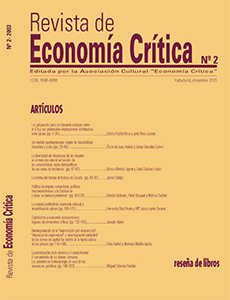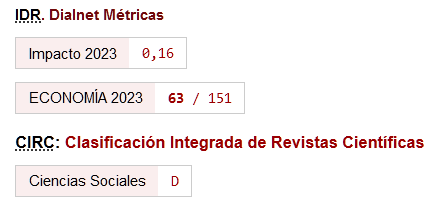Un modelo postkeynesiano simple de inestabilidad financiera y ciclos
Keywords:
business cycles, financial instability, post-Keynesian modelsAbstract
This paper analyzes the interaction between the real sector of the economy (represented by the rate of growth) and the financial sector (represented by the rate of interest). We apply the preypredator model proposed in 1926 by the natural scientists Lotka andVolterra. This model was applied to Economics for the first time by Goodwin in 1967. Contrary to conventional models of economic cycles, whose starting point usually is an exogenous shock on the real sector, our attention will focus on the causes of financial instability. We shall also analyze the transmission mechanisms towards the real sector and the circumstances that bound cycles between certain limits, as we can observe in real life.
Downloads
References
ALEXANDER, S.S. (1949): "The accelerator as a generator of steady growth", The Quarterly Journal of Economics, pp. 174-197. https://doi.org/10.2307/1883097
BRICALL, J.M. y DE JUAN, O. (eds.) (1999): Economía política del crecimiento, fluctuaciones y crisis, Barcelona, Ed. Ariel.
DAVIDSON, P. (1978): Money and the Real World, Londres, McMillan. https://doi.org/10.1007/978-1-349-15865-2
DE JUAN, O. (1999): "Largas olas de prosperidad y depresión en la dinámica capitalista", en Bricall y De Juan, cap. 2, pags. 46-82.
DE JUAN, O. (2002): "El tipo de interés, ese frágil eslabón entre el circuito económico real y financiero", en De Juan y Febrero (eds.): La fragilidad financiera del capitalismo, Cuenca, Ediciones de la Universidad de Castilla - La Mancha.
GANDOLFO, G. (1997): Economic Dynamics, Berlín, Springer Verlag. https://doi.org/10.1007/978-3-662-06822-9
GONZÁLEZ CALVET, J. y SÁNCHEZ CHÓLIZ, J. (1994): "Notes on Jarsulic's endogenous credit and endogenous business cycles", Journal of Post Keynesian Economics, vol. 16, nº 4, pgs. 605-618.
https://doi.org/10.1080/01603477.1994.11490002
GONZÁLEZ CALVET, J. (1999): "Los ciclos: aspectos reales y financieros", en Bricall y De Juan, cap. 4, pgs. 137-172.
GOODWIN, R.M. (1967): "A growth cycle", en C.H. Feinstein (ed): Socialism, capitalism and economic growth, Londres, MacMillan, pp. 165-170. https://doi.org/10.1007/978-1-349-05504-3_12
HARROD, R.F. (1939): "An essay in dynamic theory", Economic Journal, v. 49, pgs. 14-33.
https://doi.org/10.2307/2225181
HIRSCH, M. W. y SMALE, S. (1974): Differential equations, dynamical systems and linear algebra, Boston, Academic Press.
JARSULIC, M. (1989): "Endogenous credit and endogenous business cycles", Journal of Post Keynesian Economics, vol. 12, nº 1, pgs. 35-48. https://doi.org/10.1080/01603477.1989.11489779
KALDOR, N. (1982): The Scourge of Monetarism, Oxford, Oxford University Press.
KEYNES, J.M. (1936): The general theory of employment, interest and money, Londres, Macmillan. [Versión castellana en 1943: Teoría general de la ocupación, el interés y el dinero, México, F.C.E.]
KINDLEBERGER, C.P. (1989): Manias, panics and crashes, Nueva York, Basic Books, ed. revisada [Versión castellana de 1991: Manías, pánicos y cracs. Historia de las crisis financieras, Barcelona, Ariel].
LAVOIE, M. (1992): Foundations of Post-Keynesian Economics, Aldershot, Edward Elgar.
MINSKY, H. (1975): John Maynard Keynes, Nueva York, Columbia University Press. [Versión castellana de 1987: Las razones de Keynes, México, F.C.E.]. https://doi.org/10.1007/978-1-349-02679-1
MOORE, Basile J. (1988): Horizontalist and verticalist: the macroeconomics of credit money, Cambridge, Cambridge University Press.
SEMMLER, W. (ed.) (1989): Financial Dynamics and Business Cycles: New Perspectives, Armonk, M.E. Sharpe.
SCHUMPETER, J. (1912): Theorie der Wirtschaftlichen Entwicklung, Leipzig, Dunker & Humbolt [Versión inglesa de 1934: The Theory of Economic Development, Cambridge, Mass, Harvard University Press; versión castellana de 1966: La teoría del desenvolvimiento capitalista, México, F.C.E.].
WRAY, L. Randall (1990): Money and credit in capitalist economies, Cheltenham, UK, Edward Elgar.
Downloads
Published
How to Cite
Issue
Section
License
This licence allows third parties to share (copy and redistribute the material in any medium or format) and adapt (remix, transform and create from the material for any purpose, including commercial purposes), provided that authorship and first publication in this journal (The Journal, DOI of the work) is acknowledged, a link to the licence is provided, and it is stated whether changes have been made to the work.







